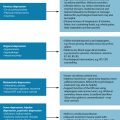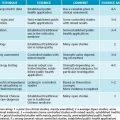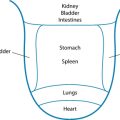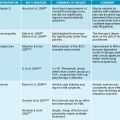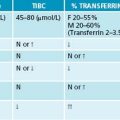Appendix 5 Factors affecting nutritional status
A variety of factors other than dietary insufficiency may influence nutritional status and therefore should be taken into account if a particular deficiency is suspected or if a specific condition present. Some conditions may increase the need for a particular nutrient, while others may interfere with its absorption or excretion.
Vitamin A
Vitamin B1
Vitamin B2
Vitamin B6
Vitamin B12
Folate
Vitamin C
Vitamin E
Vitamin D
Vitamin K
Magnesium
Calcium
Zinc
Iron
Selenium
Iodine
1. Van Leeuwen A., et L. Davis’s comprehensive handbook of laboratory and diagnostic tests with nursing implications, 2nd edn. Philadelphia: FA Davis Company; 2006.
2. Fell G., Talwar D. Assessment of status [Review article]. Curr Opin Clin Nutr Metab Care. 1998;1(6):491-497.
3. Heimburger D., et al. Clinical manifestations of nutrient deficiencies and toxicities: a resume. In: Shils M.E., et al, editors. Modern nutrition in health and disease. USA: Lippincott Williams & Wilkins, 2006.
4. Solomons N.W., Russell R.M. The interaction of vitamin A and zinc: implications for human nutrition. Am J Clin Nutr. 1980;33(9):2031-2040.
5. Mejia L. Vitamin A–nutrient interrelationships. In: Bauernfeind J.C., editor. Vitamin A deficiency and its control. Orlando: Academic Press, 1986.
6. Sauberlich H.E. Laboratory tests for the assessment of nutritional status, 2nd edn. USA: CRC Press; 1999.
7. Butterworth R.F. Maternal thiamine deficiency: still a problem in some world communities. Am J Clin Nutr. 2001;74(6):712-713.
8. Hilker D.M., Somogyi J.C. Antithiamins of plant origin: their chemical nature and mode of action. Ann NY Acad Sci. 1982;378:137-145.
9. Pinto J., et al. Mechanisms underlying the differential effects of ethanol on the bioavailability of riboflavin and flavin adenine dinucleotide. J Clin Invest. 1987;79(5):1343-1348.
10. Gibson R. Principles of nutritional assessment, 2nd edn. USA: Oxford University Press; 2005.
11. Riboflavin Rivlin R., Ziegler E.E., Filer L.J. Jr., editors. Present knowledge in nutrition, 7th edn. Washington: ILSI Press; 1996:167-173.
12. Ryan A.S., Goldsmith L.A. Nutrition and the skin. Clin Dermatol. 1996;14(4):389-406.
13. Rall L., Meydani S.N. Vitamin B(6) and immune competence. Nutr Rev. 1993;51(8):217-225.
14. Sauberlich H.E. Bioavailability of vitamins. Prog Food Nutr Sci. 1985;9:1-33.
15. Leklem J. Vitamin B6. In: Ziegler E.E., Filer L.J.Jr., editors. Present knowledge in nutrition. 7th edn. Washington: ILSI Press; 1996:175-183.
16. Ralph C. Subtle and atypical cobalamin deficiency states. Am J Hematol. 1990;34(2):108-114.
17. Kanazawa S., Herbert V. Total corrinoid, cobalamin and cobalamin analogue levels may be normal in serum despite cobalamin in liver depletion in patients with alcoholism. Lab Invest. 1985;53:108-110.
18. Cooke W., et al. The clinical and metabolic significance of jujunal diverticula. Gut. 1963;4(2):115-131.
19. Herbert V. Making sense of laboratory tests of folate status: folate requirements to sustain normality. Am J Hematol. 1987;26(2):199-207.
20. Thongprasom K., et al. Folate and vitamin B12 levels in patients with oral lichen planus, stomatitis or glossitis. Southeast Asian J Trop Med and Public Health. 2001;32(3):643-647.
21. Bonjour J.P. Biotin in man’s nutrition and therapy—a review. Internat. J Vit Nutr Res. 1977;47:107-118.
22. Basu T. The influence of drugs with particular reference to asprin on the bioavailability of vitamin C. In: Counsell J., Hornig D., editors. Vitamin C. London: Applied Science Publishers; 1981:273-281.
23. Rader D.J., Brewer H.B.Jr. Abetalipoproteinemia: new insights into lipoprotein assembly and vitamin E. Metabolism from a rare genetic disease. JAMA. 1993;270(7):865-869.
24. De Leenheer A.P., et al. Chromatography of fat-soluble vitamins in clinical chemistry. J Chromatogr. 1988;429:3-58.
25. Kalra V., et al. Vitamin E deficiency and associated neurological deficits in children with protein–energy malnutrition. J Trop Pediatr. 1998;44(5):291-295.
26. Kelly F.J., et al. Time course of vitamin E repletion in the premature infant. Br J Nutr. 1990;63(3):631-638.
27. Bieri J.G., Evarts R.P. Tocopherols and polyunsaturated fatty acids in human tissues. Am J Clin Nutr. 1975;28(7):717-720.
28. Sokol R.J., et al. Vitamin E deficiency neuropathy in children with fat malabsorption studies in cystic fibrosis and chronic cholestasis. Ann N YAcad Sci. 1989;570:156-169.
29. Fatemi S., et al. Effect of experimental human magnesium depletion on parathyroid hormone secretion and 1,25-dihydroxyvitamin D metabolism. J Clin Endocrinol Metab. 1991;73(5):1067-1072.
30. Krasinski S.D., et al. The prevalence of vitamin K deficiency in chronic gastrointestinal disorders. Am J Clin Nutr. 1985;41(3):639-643.
31. Olson R. The function and metabolism of vitamin K. Ann Rev Nutr. 1984;4:281-337.
32. Ryzen E. Magnesium homeostasis in critically ill patients. Magnesium. 1989;8(3–4):201-212.
33. Groff J., Gropper S. Advanced nutrition and human metabolism, 3rd edn. USA: Wadsworth/Thompson Learning; 2000.
34. Whang R., et al. Magnesium homeostasis and clinical disorders of magnesium deficiency. Ann Pharmacother. 1994;28(2):220-226.
35. Kesteloot H., Joossens J.V. The relationship between dietary intake and urinary excretion of sodium, potassium, calcium and magnesium: Belgian Interuniversity Research on Nutrition and Health. J Hum Hypertens. 1990;4:527-533.
36. Rude R.K. Magnesium deficiency: a cause of heterogenous disease in humans. J Bone Mineral Res. 1998;13(4):749-758.
37. Maclean A.R., Renwick C. Audit of pre-operative starvation. Anaesthesia. 1993;48(2):164-166.
38. Prelack K., Sheridan R.L. Micronutrient supplementation in the critically ill patient: strategies for clinical practice. J Trauma. 2001;51(3):601-620.
39. Kerstetter J.E., et al. Dietary protein affects intestinal calcium absorption. Am J Clin Nutr. 1998;68(4):859-865.
40. Hannan M.T., et al. Effect of dietary protein on bone loss in elderly men and women: the Framingham Osteoporosis Study. J Bone Miner Res. 2000;15(12):2504-2512.
41. Mahalko J.R., et al. Effect of a moderate increase in dietary protein on the retention and excretion of Ca, Cu, Fe, Mg, P, and Zn by adult males. Am J Clin Nutr. 1983;37(1):8-14.
42. Pironi L., et al. Urinary zinc excretion in Crohn’s disease. Dig Dis Sci. 1987;32(4):358-362.
43. Cousins R.J. Zinc. In: Ziegler E.E., Filer L.J.Jr., editors. Present knowledge in nutrition. 7th edn. Washington: ILSI Press; 1996:293-306.
44. Smith H. Diagnosis in paediatric haematology. New York: Churchill Livingstone; 1996. 6–40
45. Lynch S.R. Interaction of iron with other nutrients. Nutr Rev. 1997;55(4):102-110.
46. O’Dell B. Bioavailability of and interactions among trace elements. In: Chandra R.K., editor. Trace elements in nutrition of children. New York: Raven Press; 1985:41-55.
47. Rushton D.H. Nutritional factors and hair loss. Clin Exp Dermatol. 2002;27(5):400-408.
48. Salmenpera L. Detecting subclinical deficiency of essential trace elements in children with special reference to zinc and selenium. Clin Biochem. 1997;30(2):115-120.
49. Gaitan E. Goitrogens in food and water. Annu Rev Nutr. 1990;10:21-39.
50. Wolff J., Chaikoff I.L. Plasma inorganic iodide as a homeostatic regulator of thyroic function. J Biol Chem. 1948;174(2):555-564.


